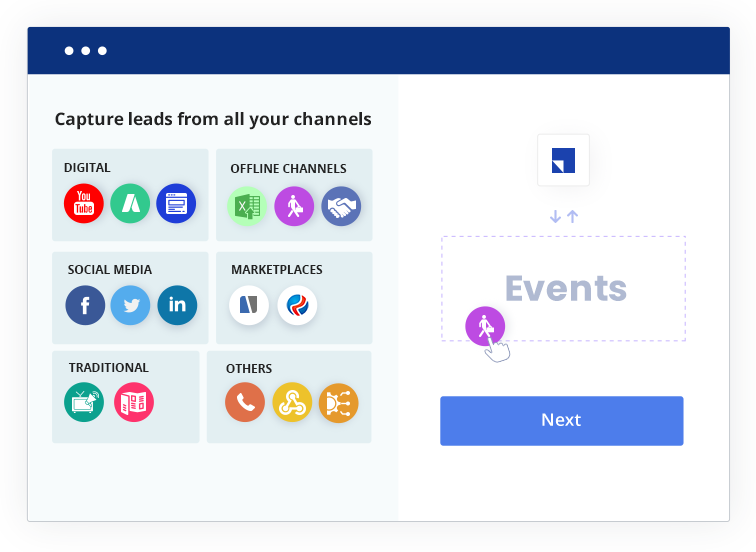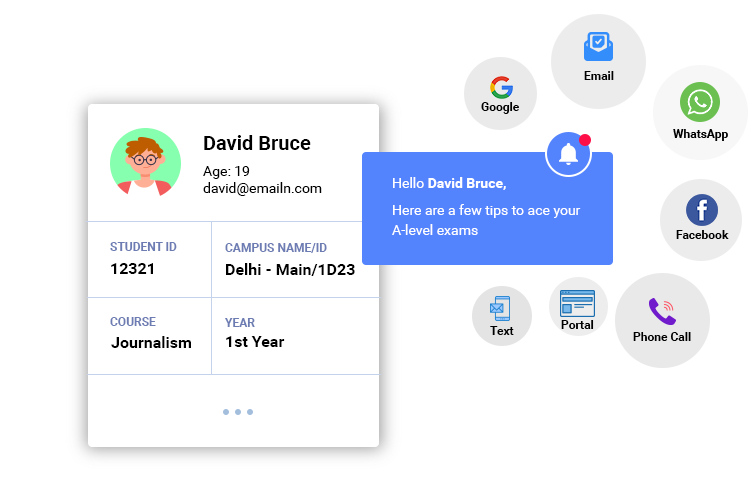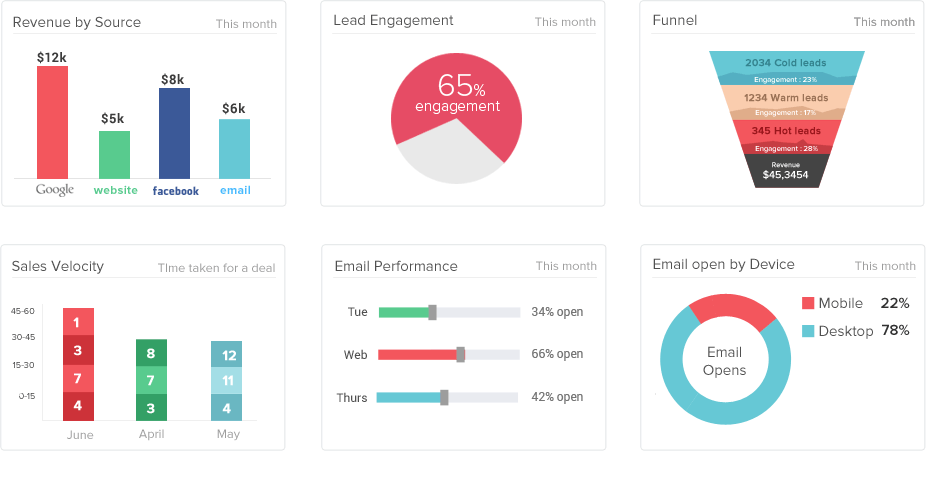Your marketing campaigns may have specific goals. It could be something like reaching a particular consumer segment or increasing brand visibility. For instance, Coke’s Share a Coke campaign aimed at increasing the consumption of Coca-Cola during the summer. Dove’s Real Beauty campaign or the Always #LikeaGirl campaign addressed social cause.

If you noticed, these brands did not advertise only on a particular channel. They used blog posts, social media posts, video conferences, along with traditional TV ads and billboards. However, the catch is – marketing efforts are successful when they target the customers on the platforms/channels where they are most active. Thus, you need to monitor the engagement rate, activities and reach of your campaigns on different channels. Now, this is where campaign management software comes into the picture. It helps you align your marketing strategies and manage activities across several channels to achieve maximum ROI from your campaigns.
In this article, we will discuss in what ways campaign management software improves marketing ROI. So, let us dive into the details.
What is campaign management software?
Campaign Management software is a digital tool that enables sales and marketing teams to plan campaigns, track their performance, measure the effectiveness of different channels and copies, and automates reporting & analysis of marketing campaigns to a granular level.
It allows marketers to schedule and promote ads by integrating different platforms and customer data sources. Often companies use CRM software or marketing automation suite for campaign management.
Table of contents
- The benefits of using campaign management software
- Reduce lead acquisition time
- Reduce staffing cost
- Plan multi-stage campaigns
- Design multi-channel and omnichannel interactions
- Manage campaign workflows
- Target the right audience
- Schedule set-it-and-forget-it email campaigns
- Manage and control your budget
- Track progress
- Analyze campaigns and generate reports
- Conclusion
The benefits of using campaign management software
Marketing communication has changed over time and has become more interactive. Earlier, a support center was the medium for communication between brands and customers. Now, brands engage directly with the audience through blog posts, social media, video conferences, and more. Marketing campaigns often have a lot of moving parts. It is because a campaign runs through multiple platforms – both online and offline.
Brands now have campaign managers who run such campaigns. They are responsible for the distribution of marketing collaterals, as well as tracking their performance. Managers optimize the campaign strategy over time by looking at how well the current one is performing. To automate routine tasks like report generation, auto-response to a customer query, and scheduling posts, campaign management software comes in handy. 74% of marketers agree that automation saves time. 45% of agencies depend on automation technologies for their ROI.
Campaign management software brings transparency as well in addition to automation. Over the last few years, automation has taken over in different workplaces. Companies now need less staff to get something done. Automation does not necessarily replace people, but they assist people in getting the job done faster and more accurately, allowing them more time to concentrate on strategy. Implementing automation in marketing increases operational efficiency to a great extent.
Brands use different kinds of software to manage campaigns. Often these programs include project management programs, CRM solutions, to-do lists, and more. However, there are also dedicated programs that allow working on complicated projects collaboratively. Here are the remarkable benefits of using software for campaign management.
Reduce lead acquisition time
Campaigns require thorough planning before their execution. Often campaigns are time-sensitive. For instance, brands can target the Super Bowl or the Christmas holidays for an advertisement campaign. Brands can launch new products during the back-to-school season or give a stock-clearance sale on Black Friday. Planning a campaign takes time. However, by using the right software, brands can reduce their lead acquisition time from weeks to days.

Campaign management software also helps brands to schedule emails or posts on social media. They can automate complex workflows so that all the stakeholders know what to do at the right time. This workflow management will ensure that the marketing collaterals are distributed at the right time and will reach the audience accordingly.
Reduce staffing cost
By using the right software, brands can drastically cut down the costs of the sales and marketing department. An effective campaign does not require a fifty-person marketing department. Now, brands can use software to nurture and monitor leads. Automated campaigns take a little time to set up. Campaign managers can define what action the software will take when certain events are triggered. Once the software is online, it acts automatically. Management can set the software to handle interactions with the audience. Humans can step in for more serious conversations. Automation reduces the need to have a well-staffed department. A few competent people can supervise sophisticated campaigns without breaking a sweat.
Plan multi-stage campaigns
The multi-stage campaign is a technique where the brands communicate with the audience in stages.
For example, for a product launch, the brand can first introduce the product in a launch campaign. In the next drive, it can reveal the pricing and specifications. The subsequent campaigns can be about availability and offer on the product.
Breaking the campaign into smaller pieces makes sure that the audience does not forget the products. It creates a buzz (or sensation) and curiosity for the products. With campaign management software, it becomes easier to schedule these events. The manager can plan the activities ahead of time, decide the order of events, and automate them. Once all the assets are ready, the company can create emails or posts and schedule them.
Design multi-channel and omnichannel interactions
Multi-channel marketing is essential since you must be there where your customers are. Nowadays, consumers have a lot more control over the buying process. Also, the consumer can get information about the product from various channels. They judge products/services based on reviews – even if it is from people they never met. Therefore, the brands need to be available on these channels to communicate with potential consumers.
However, while targeting multi-channel, marketers must know the customer activities across all channels. For example, a customer posted negative feedback about your product on Instagram. Your social media manager informed you about the customer, and you decide to call the customer to address the concern.
Now, if you will ask the customer that what his/her concerns are, then that person would say – I have already mentioned it on Instagram, and you must refer to that.
Instead, if you will ask the customer that you have understood his/her concerns, and here is the solution, then it will impart a good brand impression on the customer.
The point is – if you are aware of the customer interactions across different platforms, then your communication can be more effective.

Omnichannel communication is a very consumer-friendly approach that allows the consumer to choose their preferred channel. The essence of omnichannel communication is that communicating parties can seamlessly switch channels without having to start over. It ensures the continuity of conversations. For example, a consumer may find a campaign compelling and contact the brand via the web form. Later, they can continue talking via social media or instant messaging without losing context.
Campaign management software allows brands to run campaigns across multiple channels simultaneously and unify customer interactions across different channels.
Manage campaign workflows
Software for campaign management comes with custom workflow management. The workflow management feature is crucial for setting up complex schedules. It allows the brand to prioritize what is important and act accordingly. To make a campaign effective, a brand must ensure that the campaign sticks to the cost and time budget. With workflow, teams, and time management becomes much simple. Plus, some programs have automated scheduling features. With automated scheduling, the program can automatically assign tasks and roles to employees. Automation in marketing can increase the number of qualified leads up to 451% (source: business2community). The software can also manage external agencies and vendors who are involved in the campaign.
Case study: how to increase enrollment rates through marketing automation:
Target the right audience
For any campaign, targeting the right audience is extremely crucial. Campaign management programs can mine customer information and break it up into segments. It will make it easier for brands to understand their customers and target them accordingly through specific campaigns. The programs can consider customer details and more, including transaction history and channel preferences. Brands can also leverage this information to create cross-channel campaigns and target the appropriate groups.
Schedule set-it-and-forget-it email campaigns
Email campaigns are still one of the most effective ways of getting in touch with your audience. Campaign management tools can help generate automated personalized emails to build better customer relationships. One can set up email campaigns quickly. There are a lot of mature tools available that can help with email templates. Also, it is outright easy to capture and analyze data. With campaign management tools, you can schedule emails in advance and roll them out all at once or in stages. Scheduled emails are a great way to stay on time. It is particularly useful for multi-stage campaigns.
Manage and control your budget
With automation, it is easier to track resources. Brands can set a pre-allocated amount of resources for a campaign. However, if one is not careful, overshooting these limits are common. It happens a lot during creative campaigns. The software will help create a workflow respecting the constraints. Manually managing campaign resources can be challenging. With a proper plan set up right at the beginning, brands can optimize time and resources. Moreover, you can shortlist the platforms/channels that work for you and accordingly adjust your spending across platforms.

Track progress
With campaign management software, one can track user engagement in interactive and visual dashboards. You can see how users are interacting with the marketing collaterals across different channels. Marketers can change content on the fly to improve engagement. Tracking progress is also crucial to check if the campaign has a positive reception from customers. It will allow the brand to respond to the issue immediately.
Analyze campaigns and generate reports
Brands can also use dashboards to understand if the campaign has reached its goal. When a brand plans a campaign, they have specific targets in mind. It can be launching and promoting a new service or a product or targeting a segment of the audience.
Goals should always be achievable and measurable. Otherwise, marketers will not be able to quantify success. Therefore, brands need to define their marketing goals with numbers. An example would be the goal of a 10% increase in sales. This goal can be analyzed using the dashboard of campaign management tools.
Conclusion
Time is precious in the current business scenario. To stay competitive, companies must focus on automating repetitive marketing tasks. Several types of marketing campaigns are a tried-and-tested method of engaging customers. However, campaigns have evolved a lot over the last few decades. Campaigns are no longer just newspaper and radio advertisements. They are interactive digital content. Managing such campaigns on different channels can be expensive if not managed well. Brands need to spend time and money to get them right. In such scenarios, mistakes can be quite costly. For instance, if a campaign has a negative reception, then it might tarnish the brand image. In those cases, damage control can be even more expensive. Hence, brands must be extremely diligent while planning and executing campaigns. Using automation helps avoid mistakes while reducing time and cost. In turn, this also improves the return on investment.
If you are looking for campaign management and end-to-end customer relationship management, then you must try LeadSquared sales and marketing CRM software once.
Read further:








